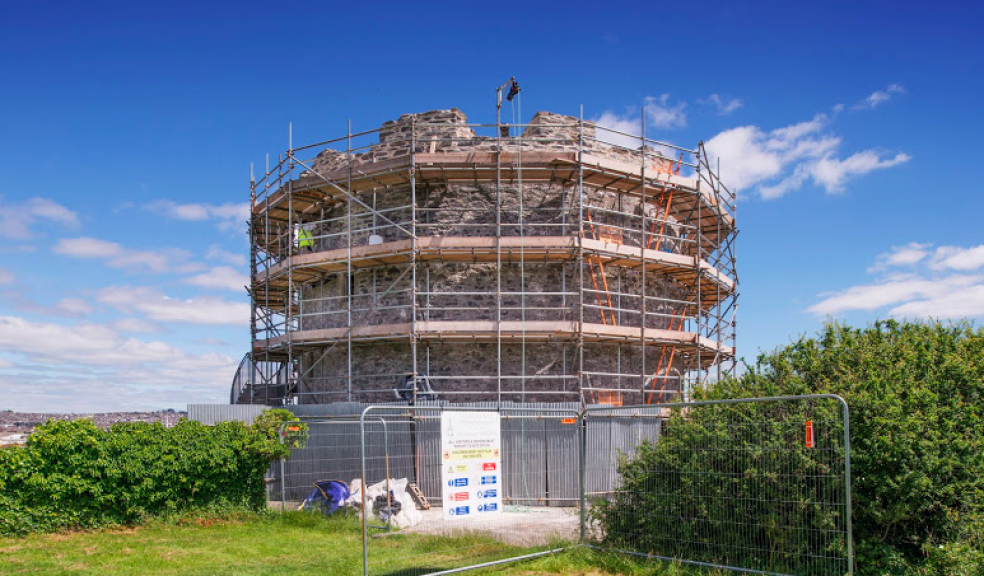
Historic England reveals heritage at risk in SW
Medieval Ruthern Bridge, protected wreck HMS Colossus and Plymouth’s Crownhill Fort are among the 82 vulnerable historic gems newly added to Historic England’s Heritage at Risk Register 2016 in the South West, revealed today (Friday 21 October 2016).
However 103 entries have been successfully removed from the Register this year in the South West including Cow Cave in Chudleigh Rocks which contains important prehistoric animal and plant remains, the Stripple Stones ‘stone circle’ monument on Bodmin Moor and Landewednack Windmill in Cornwall.
Historic England’s Heritage at Risk register gives an annual snapshot of the condition of the South West’s most important historic buildings, sites, monuments and places. Across the region 103 sites have been repaired and removed from the Register, while 82 sites have been added to the Register because of concerns about their condition including 14 places of worship. Over the past year, Historic England has offered £1.2 million in grants to help 66 of the region’s best loved and most important historic sites.
The Heritage at Risk Register 2016 reveals that in the South West, 161 Grade I and II* buildings, 1,144 scheduled monuments, 178 places of worship, 17 registered parks and gardens, one battlefield, one protected wreck site and 34 conservation areas are at risk of neglect, decay or inappropriate change. There are 1,536 assets on the South West Register, 26 fewer than in 2015.
John Ette, Heritage at Risk Principal for Historic England in the South West said: “The South West has over a quarter of the nationally-important sites in England. From prehistoric monuments and landscapes to industrial buildings and military heritage, there are many challenges when sites become at risk. Historic England is working with owners, councils and communities giving advice and grants to help secure the future of the South West’s heritage.
John Ette continued: “This year we have removed 103 sites from the register including imaginative restoration projects such as the windmill on the Lizard Peninsular and Bury Castle Hillfort in Devon, but there is still more to do especially as the cost of conservation and rescue is increasing.”
PLYMOUTH HIGHLIGHTS
PLYMOUTH FORTS – EXCELLENT PROGRESS TOWARDS REPAIRS AND CROWNHILL FORT - ADDED TO THE REGISTER
The South West is well known for its outstanding military heritage and its array of 19th century hilltop forts around Plymouth, which were built to help protect the coast and England from invasion.
Since 2014, Historic England has been grant-aiding condition surveys for four fortifications owned by Plymouth City Council to determine what repairs are needed at each one. Three of these are ‘Palmerston Forts’ built in the 19th century around the north side of Plymouth against the threat of attack via land, from Napoleon III, and the fourth is a gun tower on Plymouth Sound, directly opposite the Citadel.
This year works at grade II* Mount Batten Tower, the gun tower at Mount Batten Point, are almost finished and have included grouting voids in the walls, (which are over three metres thick), repointing, and repairs to the roof. The site was only added to the register last year due to water leaking through the walls, rotting lintels and falling stone. Historic England and Plymouth City Council have been funding the repairs and the tower is now free of leaks and the stonework and lintels are secure. Mount Batten Tower is on schedule to be removed from the Heritage at Risk register next year. A guard-rail around the parapets is also due to be built paid for by the Coastal Revival Fund.
At Knowle Battery, remains from its use as a swimming pool have been removed and the roof has been repaved. Work inside was waiting for rehousing of bats which were living there, and will include repairing timber floors and putting back window frames. This work should be completed by the end of the year.
Work to drain water from the ditch and caponier at Woodland Fort will start this autumn and a programme of repairs is being developed for the fourth site at Fort Austin. This is a complex site with important later alterations dating from the First and Second World Wars and from the Cold War.
CROWNHILL FORT – (ADDITION)
Crownhill Fort is the best preserved of Plymouth’s Victorian Defences and is owned and managed by the Landmark Trust. Crownhill Fort’s buildings have been given many new uses to generate income for the structure’s maintenance and upkeep but it was added to the Heritage at Risk Register this year because of scrub and tree growth over the very large bank which slopes down from the fort and repairs that are needed to some of the smaller buildings on the site.
HIGHLIGHTS IN DEVON
Gunpowder Factory at Powder Mills, Dartmoor (ADDITION)
Devon’s only 19th century Gunpowder Factory at Powder Mills dates to 1844 and comprises at least 18 buildings involved in the production, storage and management of gunpowder. Powder Mills has been added to the register this year because these buildings are now vacant and neglected, and there are unmanaged trees growing across the site. Last year, a fallen tree knocked down the gable end of one of the buildings.
Tavistock Abbey, Tavistock, West Devon (ADDITION)
Grade I Tavistock Abbey is central to the history and character of the medieval town of Tavistock. The Saxon foundation of the abbey places it amongst the earliest of the medieval religious houses founded in Britain and its occupation from 974 to 1579 included a Benedictine order for over five and a half centuries. Tavistock Abbey has been added to the Register this year because the ruins are suffering from water damage and unmanaged scrub growth. Historic England has offered a grant to carry out a condition survey and conservation management plan for the West Gate House also known as Betsy Grimbals Tower and the Still Tower.
Bury Castle Hillfort, near Torridge, Devon (REMOVAL)
Bury Castle Hillfort in Huntshaw Wood is an Iron Age hill fort, likely to have been occupied in the first millennium BC. In its original setting, the hillfort had wide-ranging views of the River Torridge and across high ground towards the coast and toward Exmoor.
Since Victorian times, the site has been planted with trees and most recently was worked as a commercial forestry plantation. It was placed on the Heritage at Risk Register in 2010 because tree roots, scrub and modern forestry vehicles posed a threat to the survival of both earthworks and buried archaeology.
Bury Castle Hillfort has now been removed from the Register this year following vegetation management and site clearance with the help of local volunteers. The landowners, Clinton Devon Estates, worked in partnership with a newly-formed community group, the Friends of Berry Castle and funded by a grant from Historic England. They were able to remove all the modern plantation trees from the site and clear it of scrub; rescuing it from decay and providing public access.
Cow Cave, Chudleigh Rocks (REMOVAL)
Deep in the cave system surrounding Chudleigh in Devon, important prehistoric animal and plant remains are preserved. Dating from the Palaeolithic (or Old Stone Age), which in Britain spans a period from at least 700,000 years ago until around 12,000 years ago, the cave shelter known as Cow Cave is an extremely rare site, containing some of the oldest remains of the earliest inhabitants of Britain.
These prehistoric remains have been at risk of damage from erosion caused by visitors exploring or taking shelter in the cave, digging fire pits and lighting fires. They were also affected by heritage crime including, graffiti on the walls, as well as erosion caused by heavy rain.
Cow Cave has been removed from the Heritage at Risk Register this year because in advance of a grille being inserted within the cave entrance to stop unauthorised access, a ‘rescue’ excavation was carried out to recover evidence from damaged prehistoric remains before they are lost.
Funded by Historic England with Devon County Council and the landowner, the excavations have recovered important remains that have been sent off for detailed scientific analysis. The final report is due later this year but there are already exciting indications of the animal and plant species that were in and around the caves thousands of years ago. Historic England is pleased to be able to fund this special project aimed at recovering vital information about our very distant past.
HIGHLIGHTS IN CORNWALL
Ruthern Bridge, near Bodmin (ADDITION)
Historic Ruthern Bridge dates back to the 15th century, and despite some alterations and strengthening in the 20th century, remains a very well-preserved example of a late medieval bridge. It is in an attractive rural setting, approached by quiet minor roads. However, the bridge, which is very narrow, has been added to the ‘at risk’ register this year due to repeated traffic damage. The parapet has been hit by vehicles on numerous occasions, often several times a year, requiring frequent repairs. Scratches and gouges on the parapet walls remain as permanent evidence of this constant damage to the historic fabric of the bridge. Cornwall Council is in discussions with Historic England and the parish council about ways to align traffic approaching the bridge so that traffic damage to the bridge is minimised.
HMS Colossus Protected Wreck Site off The Isles of Scilly (ADDITION)
HMS Colossus is a 74-gun third rate Georgian warship which sunk off the Isles of Scilly in 1798. HMS Colossus has been the focus of a number of Historic England funded projects led by the Cornwall and Isles of Scillies Maritime Archaeology Society including an excavation and the creation of an underwater dive trail of the wreck. Despite these initiatives, HMS Colossus has become high risk as the material on the sea bed continues to be exposed and vulnerable. Once exposed, the archaeological remains of the wreck are at risk of getting dispersed around the protected area as well as further afield and are at immediate risk of loss.
Landewednack Windmill on the Lizard Peninsula, Cornwall (REMOVAL)
Landewednack Windmill is a very early tower mill which is a scheduled Monument as well as being listed at grade II. It dates from the late 17th century and was originally used for grinding grain. The mill is a prominent feature in the Cornish landscape, serving as a famous land and sea mark. It was reused in the Second World War as a Home Guard observation platform and is owned by the Cornwall Wildlife Trust. It was added to the Heritage at Risk Register in 2013 due to structural problems following removal of a temporary roof in the 1960s. The building was in a fragile state, requiring urgent repair and conservation.
Landewednack Windmill has been removed from the Register this year because an innovative solution was found for its structural problems. Historic England worked with the Cornwall Wildlife Trust, Natural England and the Heritage Lottery Fund (HLF), to construct a free-standing structure within the shell of the windmill to support a roof, spiral steps and a viewing platform. The roof will help to protect the tops of the walls. These repairs not only rescued the building but also provided a new use for it, allowing visitors to overlook the Lizard and the nearby nature reserve.
Mawgan Porth Dark Age Settlement, Mawgan-in-Pydar (REMOVAL)
Mawgan Porth Dark Age settlement dates to the early medieval period and is exceptionally rare, especially in Cornwall. The fact that the settlement is associated with a cemetery adds greatly to the site’s importance, because this combination is not found anywhere else in Cornwall. The number and good survival of the burials is also unusual and the alkaline quality of the sand that buried the site means that preservation of the skeletal remains is exceptionally good. The site was considered to be at risk due to increasing scrub growth and the potential threat of development. It has now been removed from the Register after a group of volunteers, supported by Historic England raised funds to buy tools, weed killer and grass seed to clear the scrub and grow grass on the site.
Stripple Stones Stone Circle on Bodmin Moor (REMOVAL)
The Stripple Stones is a rare example in Cornwall of a henge, with stone circle inside it; and unusually for Cornwall, the circle has a central stone. It is located on Bodmin Moor, just below Hawkstor and within sight of Cornwall’s highest hills - Brown Willy and Roughtor. Over the last few years, bad weather has contributed to a deterioration in the site’s condition. High rainfall has led to stock erosion in the ditches and around the stones meaning that there is a threat to below-ground archaeology and a risk to the stones’ stability. The Stripple Stones has been removed from the Register this year because conservation work and repairs funded by a grant from Natural England have taken place. This work included land management such as clearing scrub, reducing the stock that was grazing on the land from cows and sheep to sheep only, as well as making some of the fallen stones upright again.
St Buryan Churchyard Cross (REMOVAL)
St Buryan Churchyard Cross is an important example of an early Celtic Cross. The head of the cross that is mounted on top of the square stepped plinth is thought to date from the 10th century, from the time of King Athelstan. It had been ‘at risk’ because of the loss of mortar in its stepped base, leaving large gaps so that the stones forming the steps were loose, uneven, and unstable.
St Buryan Churchyard Cross has been removed from the Register this year following conservation of the steps funded by Historic England. This involved levelling up almost every stone step in the base, providing each with a secure foundation and repointing the entire monument. Through the course of the work, it was also discovered that the present steps represent a 19th century shell, constructed around an earlier flight of steps. The monument is now secure and safe.












